

|
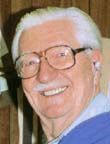
Carl Barks, the genius behind the creation of "Scrooge McDuck," the world's richest duck, and the man who drew the comic book adventures of Donald Duck, his nephews, and Uncle Scrooge back in the '40s, '50s and '60s is the subject of this page. The remarkable Mr. Barks celebrated his 96th birthday at a special celebration presented at Walt Disney World in Orlando, Florida, April 12 and 13, 1997. He is seen here on that occasion with Kathy Morby and Bill Grandey, of the Carl Barks Studio, together with 250 of his closest friends. 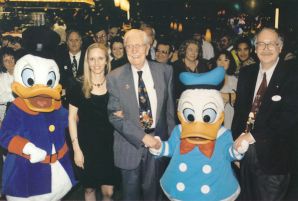
Information and commentary about Mr. Barks can be found on many web pages other than this one. Try running his name through a search engine or pursue him further via one of the links at the bottom of this page. In addition, a number of books have been written which contain biographical information and a complete survey of his career. Consequently, this page is mostly limited to information regarding the current value of original oil paintings and certain limited edition prints, signed by Mr. Barks. In addition, I hope to be a sort of central point for compiling the opinions of fans regarding which of the famous Barks oil paintings is the "best" one. If you are unfamiliar with the existence of, or the market for, these items, the following will serve as a brief introduction. ORIGINAL ART Following his retirement many years ago, Mr. Barks began to render a series of oil paintings featuring the Disney ducks. There have now been well over 100 of these paintings. Among the most popular are those which feature Scrooge McDuck enjoying the contents of his famous "money bin." Each of these oil paintings also features Donald Duck and his three nephews. Only 20 or so of the oil paintings are set in the money bin and it is rare for one of them to be offered for sale. Mr. Barks was involved in duck-related projects until the end. He passed away August 25, 2000, at the age of 99. LIMITED EDITION LITHOGRAPHS Barks lithographs have appeared from more than one source, but the best known and most popular are those issued by a company called "Another Rainbow." 
The first lithograph in this series, "Sailing the Spanish Main," appeared in 1981. This print was limited to a single edition of 245 copies and is today the most sought after and valuable of all the Barks lithographs. Its estimated value as of May 2000, is $11,000. Copies in less than "mint" condition, or without the certificate of authenticity have sold for significantly less than that in recent years. Each of the lithographs in the "Another Rainbow" series is taken from an original oil painting. Except for the first one, they have been issued in more than one edition, the most limited of which is the "Gold Plate" edition, consisting of only 100 copies in the numbered set. Most of these prints have been produced using 10 or more colors in a continuous-tone process on Opalesque Keramique stock by the Black Box of Chicago. 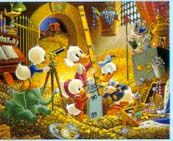
These limited edition prints are signed by Mr. Barks and are somewhat expensive by most folks' standards. Here are two other examples from the series. The first, entitled An Embarrassment of Riches, is set in the famous "money bin" of Uncle Scrooge. This 1983 print was the second in the long series of lithographs. The edition consisted of 395 copies--there was no Gold Plate edition at that time. This lithograph has since increased in value by a factor of 10, the May 2000 estimate of its value being $4,300. Copies from the 500 print edition produced for sale in The Sharper Image catalog would, no doubt, command a somewhat lesser price. 
The second is entitled An Astronomical Predicament. The current estimated value of the Gold Plate edition of this 1990 print is $1500, more than twice its original price. More than 30 lithographs in various sizes have been issued by this company. Expensive or not, Another Rainbow lithographs usually sell out very rapidly, sometimes even during the advance order or prior-to-issue period. There is, however, an active secondary market in these items and it is not usually difficult to find one, if you are willing to spring for the current price. Many of the lower demand (or large or multiple edition) lithographs can be found at relatively agreeable prices if you shop around or buy directly from other collectors. 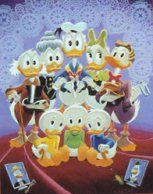
Indeed, this is the case with respect to "Lavender and Old Lace," one of the nicer "small" lithographs, having an image area of only 8" x 10". As recently as July 1997, copies of the "regular edition" of 595 copies were being offered for as little as $189. However, in fairness to those seeking investment value, I should mention that this lithograph, as well as most of the other more recent releases, have been produced in several editions, for both foreign and domestic markets. As a result, relatively large numbers of these lithographs, in one format or another, are on the market. Parties interested in information regarding the availability of specific lithographs and serigraphs should review my own offerings at the Carl Barks Collectibles web site. Millionaires among you may be interested in the availability of a "money bin" oil painting. This popular family-portrait image, which first appeared on the cover of a 1953 issue of Walt Disney's Duck Album comic book, has also been executed in a severely limited edition of 25 bone china figurines, sculpted and cast by Connoisseur of Malvern in London. You needn't inquire about this item unless you have spare multiple thousands of dollars just crying to be spent, but it is possible to see a picture of this amazing item. 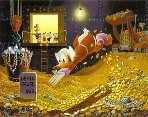
"313 Editions" in Germany is another source of Barks lithographs worthy of mention. This company has released several lithographs based on Barks oils, each in a single edition of 313 signed and numbered copies. These are very similar to the lithos from Another Rainbow but, rather than being produced on the Opalesque stock, they are printed on acid free, cotton fiber paper using a "continuous, eight-color" lithographic process. The resulting image, while quite exceptional, is a bit short of Another Rainbow's quality. One of the most recent of the "313" prints Sport of Tycoons is shown here. An article in the March/April 1998 issue of "Collector's Showcase" magazine reports that "due to certain licensing agreements," this print and the other "313" products are not offered for sale in the United States. The article goes on to state that "Only a handful of these beautiful works of art were sent to the United States before it was determined thatthey could not be sold outside of Europe." I have heard from another source that no more than 50 of these prints were made available to the US market--offered in the Spring of 1997 at $525 the copy. Considering the relatively small number in the whole edition, the desirability of this image, and its rarity on this side of the Atlantic, it could easily sell for 3 to 4 times the issue price, if you can find one. Why "313"? Well, I could say that every true Donald Duck fan knows the answer to that and leave some of you hanging. But I'm feeling charitable today--it's Donald's license plate number. LIMITED EDITION SERIGRAPHS At least three large Barks serigraphs have been issued by the Carl Barks Studios. These are also found in more than one edition, and the "deluxe" edition is quite pricey. The original issue price is as high as $3,000 and, while the editions were slow to sell out, they may have done so by now. Unlike lithographs, a serigraph (think "silk screen") has a "texture" due to the very large number of layers of color that are used to build each print. Also, two of the serigraphs were taken from relatively recent oil paintings apparently painted by Mr. Barks specifically for the purpose of giving birth to these limited editions. 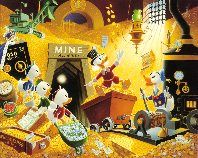
Perhaps the best known of the three is entitled Rich Finds At Inventory Time. This one is based on the largest oil painting Mr. Barks has ever done. The serigraph may or may not be exactly the same size as the painting, but it is quite large as well, measuring 28" by 35". 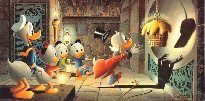
The two others in the series are not as huge as "Rich Finds" but to my eye they are superior images. The first one is the oddly shaped Golden Fleece, based on the December 1956 comic book story "The Golden Fleecing," which appeared in Walt Disney's Uncle Scrooge Comics #12. The original 12" x 24" oil was painted in 1972. The 96-color serigraph comes in "general," "remarqued," and "deluxe" editions--the latter being not on rag paper but, rather, on maple wood. Only 65 of the deluxe edition were produced and close to half of them were destroyed in a flood. In February 1998, the Carl Barks Studio estimated the value of the remaining copies at $6000. 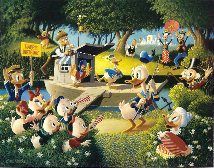
The most recent of the three is "Surprise Party At Memory Pond," a very nice 22" x 28" print from an oil painted by Mr. Barks in April 1994. In the words of the promotional literature: "with 15 characters represented, this piece is one of only a few which incorporates such a multitude of Disney characters." Of special interest are the chicken and the little remote-controlled Donald Duck toy on the boat, which harken back to Donald's first appearance as a ship's mate in the animated short "The Wise Little Hen." Most people don't remember (or never knew) why Donald wears a sailor suit. There are a number of other signed and numbered Barks lithographs and serigraphs on the market which I shall not be addressing on this page. Some feature non-Disney characters, while others are taken from watercolors or other non-oil original images, issued in connection with some "special occasion." At the risk of seeming harsh, I regard most of these as being strictly unnecessary. Some of the editions are quite large and serve little purpose other than to flood the market with Barks product. THE MARKETPLACE In recent years the prices paid for original oil paintings by Carl Barks have been dramatically on the rise. Sales figures are not always easy to ascertain. In addition to sales at public auction, it is not uncommon for sales to occur between private individuals, with details being held close to the vest. Nonetheless, some prices are published. Some of the most recent sales are discussed below. Images and prices realized of additional oil paintings and other selected works may be found on a separate Market Report page. 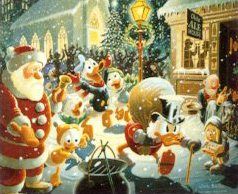
In 1995, a holiday scene entitled "A Season to Be Jolly," was sold by Diamond International Galleries for $150,000. The image (Scrooge in particular) is a very nice one. Without question, the picture contains a number of exceptional elements. Everything from Santa Claus on the left to the poor little match girl on the right. However, to my mind, it lacks something that Barks was bringing to his work when he was younger (ie. in his seventies). This is particularly notable in Donald's eyes. I find that flaws in the later work of Mr. Barks, if they are to be admitted, are most often found in the necks and eyes of the characters, a subject which could be pursued at greater length elsewhere. 
A 16" x 20" painting entitled "Trespassers Will Be Ventilated" was sold at auction in 1996 for something between $175,000 and $225,000. I apologize for not being more definite, but I don't seem to be able to put my hands on the details which got lost in one of the stacks in the back room. This is certainly a popular image, one which first appeared on the cover of Walt Disney's Uncle Scrooge Comics #2, the Spring 1954 issue, featuring the classic story "Back To The Klondike." The image in this 1987 painting was rendered in oil by Barks on three earlier occasions. Even so, some wealthy buyer was willing to pay the big bucks in order to reduce to his personal possession one of four Barks oils depicting essentially the same scene. In fairness, I should note that the other three are "vertical" in orientation and are more like each other than like this one. Still ... In rare cases, a painting is commissioned. This was reportedly the case with "Rich Finds...," for which the purchaser was said to have paid $200,000. While that particular painting is a "money bin" painting and is, also, the largest of all the original Barks oil paintings, it is surely not the "best" one. 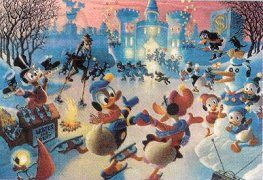
As many as a half-dozen oils have sold for $200,000 or more, the most recent example being "Mardi Gras Before the Thaw," which brought a jaw-dropping price at auction. One of Barks' larger (24" x 30") and more recent paintings, "Mardi Gras ..." was sold by Sotheby's auction house in the Spring of 1997, for a total price to the buyer of $505,000. So far as I know, this is in the area of twice what any other Barks painting has sold for. The theme is certainly happy enough and Mr. Barks has included a large number of individual characters. But, once again, it is by no means the "best" one. THE "BEST" ONE Obviously, this is a very subjective issue. When this page was first established in May 1997, I suggested that it would be interesting to know how Barks fandom at large feels on this point. I invited readers to submit their opinions to me and suggested that the candidates be limited to a list of five so-called "money bin" paintings. In November 1997, I added a special form that made it easy to register votes on the matter.
Although the voting is now over, I have left the pictures and my remarks relating to the five candidates for your enlightenment. Yes, they are all fabulous, but one of them is "the best." 
"The Secret Safe" was the first Barks money-bin painting that ever came to my attention. It was offered for sale in the first issue of Russ Cochran's original art catalog, back in the '70s, at a price of $500. Who knew that in another 25 years, you might add another three zeros to such a price? I thought this painting was remarkable then and I still think so. In those early days, Mr. Barks was guided in the selection of subject matter by the requests of prospective purchasers. Sometimes they wanted him to repeat a popular theme. Consequently, a second, nearly identical version, entitled "Who's In There" was painted shortly afterward. ProsThis was the third money bin painting, the earliest of the five featured on this page. Scrooge is exceptionally well rendered in the foreground. His suspicion and the nephews' curiosity combine to create a compelling overall theme. The picture contains several nice touches, including the book in the barrel entitled "Big Deals." ConsAs one of Mr. Barks' earlier efforts, this painting does not exhibit the mastery of lighting that he would display in some of his later ones. By comparison, the picture is a bit flat, somewhat lacking the three dimensional element found in his later oils. Also, the uniformity of expression on four of the faces, while perhaps required by the subject matter, detracts from the overall power of the piece to claim the title of "best." 
"This Dollar..." may be the best known of the money bin paintings. It has been released as a lithograph from Another Rainbow and has appeared in one of the Barks calendars from Germany. In the book "The Fine Art of Walt Disney's Donald Duck," by Bruce Hamilton and Russ Cochran, we find the following evaluation: "If a painting is to stand the test of time, ideally, it should have classic elements. No one, not even Barks, has ever painted better ducks. And the basic composition was carefully designed to carry your eye--no matter where you begin--around and back, outside to inside, always back to the dollar." The boys and Donald are at rapt attention as Scrooge recalls his adventures in the Yukon. Apparently, every coin tells a story. ProsOnce again quoting from the Bruce Hamilton, Russ Cochran book: "Many collectors feel Barks made no mistakes in his execution of this painting. ...What could be a more obvious choice for the cover of a book?" Who could disagree? The composition, the mood, the lighting, and the theme (both obvious and implied) all combine to present the near perfect realization of the Scrooge McDuck legacy. Any collector would be thrilled just to see, let alone reduce to his possession, this remarkable oil painting. ConsDespite the brilliance of this rendering, there are (at the risk of picking at nits) a couple of imperfections. By comparison to the other oils in this group, the gold coins are somewhat larger, suggesting a lesser effort by Barks in creating the large number of them. Also, while most of the ducks' expressions, postures and general demeanor are near flawless, I have always felt that the head of the nephew in the red shirt is not quite as naturally positioned or as three dimensional as the other ducks. Small points, perhaps, but nothing is perfect. 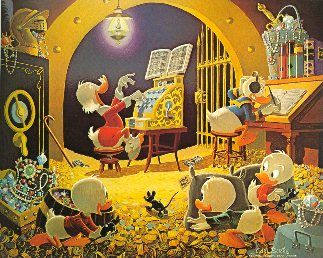
This is one of the lesser known of the money bin oils. It has not been issued as a lithograph and does not appear on a calendar, as a poster, or elsewhere, as far as I know. While many of the non-money-bin paintings are based on a comic book cover or story, each of the money bin oils is essentially "new." This one, however, does contain a favorite and familiar image--that of Scrooge playing the cash register as if it were a musical instrument. This painting, while essentially original in concept, was inspired by the cover of Walt Disney's Uncle Scrooge Comics #5, the Spring 1954 issue. The composition, circular in nature and with the cash register as its focus, is reminiscent of "This Dollar...." Poor Donald can hardly be expected to do any work while his Uncle sings at the top of his voice. ProsIn addition to the expected money bin elements, this painting contains not only excellent lighting, composition, and balance, but also tells a little story. Notice that the nephews are winding up and releasing little mechanical mice which are destined to disrupt the rapture with which Scrooge "plays" the ledger-as-sheet-music. Also the larger foreground figures combine with other elements to produce a nice three dimensional effect. ConsThe main drawback with this oil is the absence of open eyes facing the viewer. All of the ducks' expressions are well rendered and more or less dictated by the theme, but there are fewer of the classic Barks duck eyes than in some of the other oils in this group. Investors and Collectors Alert: This remarkable and highly desirable oil painting is being offered for sale by Heritage Auction Galleries in its forthcoming auction to be held August 1 - 4, 2007. The catalog mailing and Internet bidding will begin on July 14, 2007. I invite you to see details, place your bids, and follow the results of this auction at the Heritage Auction Galleries web page. 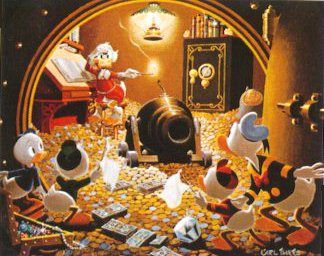
This is also one of the lesser (perhaps least) known of the money bin paintings. Apparently, even Russ Cochran could not locate it at the time his book "The Fine Art of Walt Disney's Donald Duck" was published, as it is the only money bin painting that does not appear in the larger format in this fabulous volume. The central element of the painting is based on a panel from a comic book. Actually, Barks may have used the image of Scrooge threatening to light the wick of a cannon more than once in his many comic book stories. One place you can find it is in Walt Disney's Uncle Scrooge Comics #35, the November 1961 issue, as part of a story entitled "Gift Lion." This painting is unique in that its sinister element sets it apart from all others, both in this group as well as among the money bin paintings not included here. ProsI have included this oil as a candidate largely because it is not a static image. Rather, like "Spoiling the Concert," it tells a little story and like the others in this group, it is a well conceived, well balanced, and well executed image. The excellent lighting serves to provide an unusually strong effect of three dimensions and the circular composition leads the viewer's eye in a manner similar to that found in "This Dollar..." and "Spoiling the Concert." ConsThe primary weakness of this candidate is that it lacks the element of "joy." There is little of the "feel good" charm found in several of the other candidates. Also, with most of the ducks facing away from the viewer, there is, as in "Spoiling..." a paucity of the popular "Barks duck eyes." 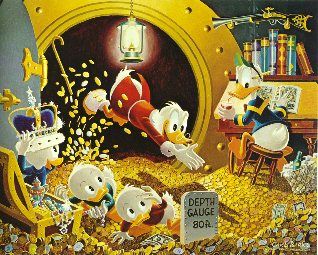
This 1974 painting is the most recent of the five in this group. It contains all the elements that any Barks fan could wish for. Here we have Scrooge diving in his money "like a porpoise," Donald reading a comic book, good expressions on all the faces, and even the depth gauge. Barks used the diving-like-a-porpoise image in many comic book stories. An early example can be found in the aforementioned Walt Disney's Uncle Scrooge Comics #2. Notice that the rendering of Scrooge in this painting is almost an exact mirror image of his figure in the "Sport of Tycoons" print from 313 Editions. This popular "Scrooge at play" image has also been rendered in bronze--a limited edition that sells for more than I like to think about. ProsSeveral desirable elements are found in this work. The "frozen moment in time" is hard to beat. The classic playfulness of the otherwise dour Scrooge, together with all the other expected elements of the money bin theme, combine to produce an oil which is exemplary of everything that one could hope to find in a money bin painting. The knowing expressions of two nephews (one also seems to be ducking) is also a nice touch. ConsThis is a small point, but, to some degree, the picture lacks the circular composition so successfully executed in some of the others in this group. Here, the composition leads the eye on the diagonal from upper left to lower right. This angle is emphasized not only in the figure of Scrooge, but also in the relative height of the three boys, even in the seat of Donald's stool. It also seems to me that the "camera" could have been pulled back a little further. The characters take up a larger share of the frame than in the other candidates. At the risk of being more critical than this wonderful piece deserves, may I also suggest what appears to be a flaw. The musket, which hangs on hooks on the wall, extends over the edge of the vault bin door frame. It is not realistic for these wall-mounted hooks to extend beyond the edge of the vault, unless the door frame is flush with the wall itself. Also, the nephew with the crown is not nearly as well executed as the other figures. 

So, there you have it. Five candidates for the title: "Best Carl Barks Oil Painting." I now invite you to view the final results of the votes that were received between November 18, 1997 and May 20, 1998. 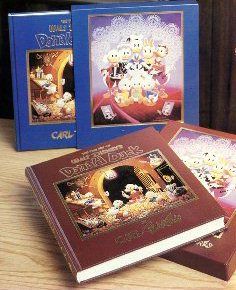
One related collectible is worthy of special attention. Indeed, I have already mentioned it several times. In 1981, Russ Cochran and Bruce Hamilton published a book entitled "The Fine Art of Walt Disney's Donald Duck," which featured color pictures of all 122 Barks Disney oil paintings produced to that date. The book was published in a very limited edition of only 1,875 signed and numbered copies, some of them in a blue binder and some in maroon. It was printed on high grade glossy paper, stitched in a heavy top-of-the-line binding, and came in a sturdy matching slipcase. The overall product was so remarkable that it won a prestigious industry award for its binding. Because of the exceptionally small print run, not to mention the extraordinary contents, this book which sold for $150 per copy upon publication will now set you back something like $2,000--if you are lucky enough to find a willing seller. Speaking of which, it just so happens there is someone (*ahem*) who has a copy for sale. 
Speaking of luck. A Carl Barks oil painting is today priced well beyond the reach of most fans. Most of us can only stand on the sidewalk with our nose pressed against the glass and dream of having an original Barks oil painting hanging above the fireplace. But, back in the 1970s it was possible to write to Mr. Barks requesting to be put on the list of those for whom he was willing to execute a painting. The list soon became too long and was probably abandoned when prices began to soar. It wasn't long before his paintings were mostly offered only at auction. Even so, a letter to Mr. Barks could still result in a personal, illustrated, response being sent to a wide-eyed fan. LINKS An Internet search for Barks-related sites will turn up a larger than expected list of results, a surprising number of them in foreign languages. Here are a few sites that I have found to be worthy of a visit:
|
|
Just click one of these icons and bookmark or make a favorite of the page it takes you to. Thereafter, your purchases from Amazon will produce a small credit to yours truly. The eBay icon takes you to a list of items that my alter ego, Otto, is offering at auction this week. Donations Are Welcome If you are one of those rare angels who would like to make a modest donation to support my efforts, you may do so by clicking the Pay Pal "Donate" image and filling in the pertinent information that will appear on the next screen. It's fast and easy and your surprising generosity will be greatly appreciated. MORE? Many other areas of the "Popular Culture Excavation Site" await you. Full descriptions are on the main menu or go directly to the area of your choice by clicking one of these seductive little images.Return to the main menu.
This page created and maintained by Jim Lowe First appearance: May 18, 1997 Last updated: June 14, 2007 |
© 1997 to 2000 and 2001 by James R. Lowe, who reserves all rights to the content of this page not successfully claimed by others. Speaking of which, the copyright to many of the images on this page is held by the Walt Disney Corporation. No fee is charged to view this page and no profit inures therefrom to its author. On the contrary, the display of such images promotes and directly enhances the value of these and related images to the Walt Disney Corporation and, in any event, are presented in the context of critical review or news commentary and are protected under the "fair use" provisions of the copyright act. So there.